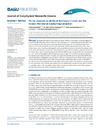Please use this identifier to cite or link to this item:
https://accedacris.ulpgc.es/jspui/handle/10553/35712
| Title: | On the seasonal variability of the Canary Current and the Atlantic Meridional Overturning Circulation | Authors: | Vélez Belchí,Pedro Perez Hernandez, Maria Dolores Casanova-Masjoan, Maria Cana, Luis Hernandez-Guerra, Alonso |
UNESCO Clasification: | 2510 Oceanografía | Keywords: | Phytoplankton Pigment Patterns Eastern Boundary Current Poleward Heat-Transport North-Atlantic Subtropical Gyre, et al |
Issue Date: | 2017 | Journal: | Journal of geophysical research. Oceans | Abstract: | The Atlantic Meridional Overturning Circulation (AMOC) is continually monitored along 26 degrees N by the RAPID-MOCHA array. Measurements from this array show a 6.7 Sv seasonal cycle for the AMOC, with a 5.9 Sv contribution from the upper mid-ocean. Recent studies argue that the dynamics of the eastern Atlantic is the main driver for this seasonal cycle; specifically, Rossby waves excited south of the Canary Islands. Using inverse modeling, hydrographic, mooring, and altimetry data, we describe the seasonal cycle of the ocean mass transport around the Canary Islands and at the eastern boundary, under the influence of the African slope, where eastern component of the RAPID-MOCHA array is situated. We find a seasonal cycle of -4.1 +/- 0.5 Sv for the oceanic region of the Canary Current, and +3.7 +/- 0.4 Sv at the eastern boundary. This seasonal cycle along the eastern boundary is in agreement with the seasonal cycle of the AMOC that requires the lowest contribution to the transport in the upper mid-ocean to occur in fall. However, we demonstrate that the linear Rossby wave model used previously to explain the seasonal cycle of the AMOC is not robust, since it is extremely sensitive to the choice of the zonal range of the wind stress curl and produces the same results with a Rossby wave speed of zero. We demonstrate that the seasonal cycle of the eastern boundary is due to the recirculation of the Canary Current and to the seasonal cycle of the poleward flow that characterizes the eastern boundaries of the oceans. | URI: | https://accedacris.ulpgc.es/handle/10553/35712 | ISSN: | 2169-9275 | DOI: | 10.1002/2017JC012774 | Source: | Journal Of Geophysical Research-Oceans[ISSN 2169-9275],v. 122 (6), p. 4518-4538 |
| Appears in Collections: | Artículos |
SCOPUSTM
Citations
21
checked on Jun 8, 2025
WEB OF SCIENCETM
Citations
21
checked on Jun 8, 2025
Page view(s)
190
checked on Jun 15, 2025
Download(s)
306
checked on Jun 15, 2025
Google ScholarTM
Check
Altmetric
Share
Export metadata
Items in accedaCRIS are protected by copyright, with all rights reserved, unless otherwise indicated.
